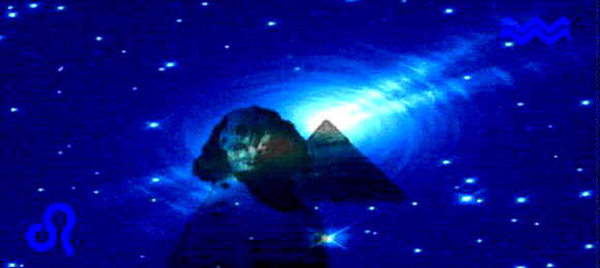
It would seem that in one way or another every ancient civilization was programmed to figure out the movements and precessions of the planets in our solar system. When we think of precession - it takes us to Precession of the Equinoxes and the position of the North Pole Star approximately every 13,000 Earth years.

In the Age of Leo 13,000 years ago - many believed the Pyramids and Great Sphinx were built when the North Pole Star was Thuban. As the planets moved, it then became Polaris.
Depending who you ask, we are now full cycle back to the age of Aquarius when the North Pole Star again becomes Thuban a binary star system in Draco - historically significant as having been the North Pole Star from the 4th to 2nd millennium BC. (Age of Aquarius).
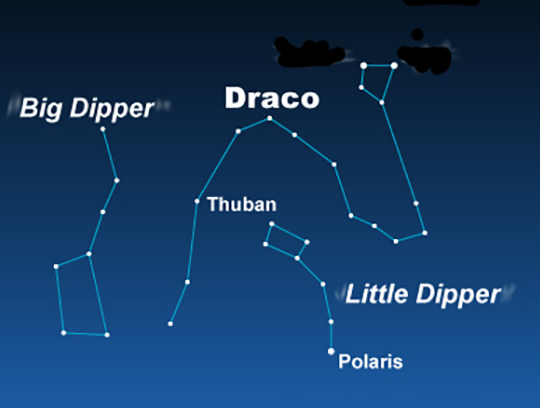
Draco is the Latin word for serpent or dragon. It is a far northern constellation that is circumpolar - that is, never setting and can be seen all year from northern latitudes - for many northern hemisphere observers. It is one of the 88 modern constellations, and one of the 48 constellations listed by Ptolemy.
Thuban was our North Pole Star approximately 13,000 years ago - (Age of Aquarius) - and will be again IFL Science - April 11, 2024

This takes us full circle to ancient symbolism - the Ouroboros, creation myths and storylines in the Simulation of Reality.
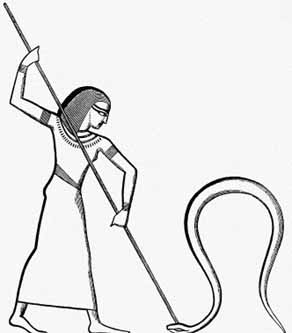
"Slaying the Dragon" - The Age of Leo is Ending.

Leo - Omega - End of Human Biogenetic Experiment
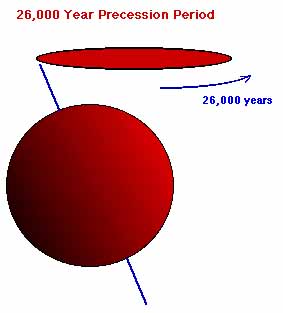
In astronomy, axial precession is a gravity-induced, slow and continuous change in the orientation of an astronomical body's rotational axis. In particular, it refers to the gradual shift in the orientation of Earth's axis of rotation, which, like a wobbling top, traces out a pair of cones joined at their apices in a cycle of approximately 26,000 years (called a Great or Platonic Year in astrology). The term "precession" typically refers only to this largest secular motion; other changes in the alignment of Earth's axis - nutation and polar motion - are much smaller in magnitude.
Earth's precession was historically called Precession of the Equinoxes because the equinoxes moved westward along the ecliptic relative to the fixed stars, opposite to the motion of the Sun along the ecliptic. This term is still used in non-technical discussions, that is, when detailed mathematics are absent.
Historically, Hipparchus is credited with discovering precession of the equinoxes. The exact dates of his life are not known, but astronomical observations attributed to him by Ptolemy date from 147 BC to 127 BC.
With improvements in the ability to calculate the gravitational force between planets during the first half of the 19th century, it was recognized that the ecliptic itself moved slightly, which was named planetary precession as early as 1863, while the dominant component was named lunisolar precession.
Their combination was named general precession instead of precession of the equinoxes. Lunisolar precession is caused by the gravitational forces of the Moon and Sun on Earth's equatorial bulge, causing Earth's axis to move with respect to inertial space. Planetary precession (actually an advance) is due to the small angle between the gravitational force of the other planets on Earth and its orbital plane (the ecliptic), causing the plane of the ecliptic to shift slightly relative to inertial space. Lunisolar precession is about 500 times larger than planetary precession.
In addition to the Moon and Sun, the other planets also cause a small movement of Earth's axis in inertial space, making the contrast in the terms lunisolar versus planetary misleading, so in 2006 the International Astronomical Union recommended that the dominant component be renamed the precession of the equator and the minor component be renamed precession of the ecliptic, but their combination is still named general precession.
The precession of the equinoxes is caused by the gravitational forces of the Sun and the Moon, and to a lesser extent other bodies, on the Earth. It was first explained by Sir Isaac Newton.
Axial precession is similar to the precession of a spinning top. In both cases, the applied force is due to gravity. For a spinning top, this force tends to be almost parallel to the rotation axis. For the Earth, however, the applied forces of the Sun and the Moon are nearly perpendicular to the axis of rotation.
The Earth is not a perfect sphere but an oblate spheroid, with an equatorial diameter about 43 kilometers larger than its polar diameter. Because of the Earth's axial tilt, during most of the year the half of this bulge that is closest to the Sun is off-center, either to the north or to the south, and the far half is off-center on the opposite side. The gravitational pull on the closer half is stronger, since gravity decreases with distance, so this creates a small torque on the Earth as the Sun pulls harder on one side of the Earth than the other. The axis of this torque is roughly perpendicular to the axis of the Earth's rotation so the axis of rotation precesses. If the Earth were a perfect sphere, there would be no precession.
This average torque is perpendicular to the direction in which the rotation axis is tilted away from the ecliptic pole, so that it does not change the axial tilt itself. The magnitude of the torque from the sun (or the moon) varies with the gravitational object's alignment with the Earth's spin axis and approaches zero when it is orthogonal.
Although the above explanation involved the Sun, the same explanation holds true for any object moving around the Earth, along or close to the ecliptic, notably, the Moon. The combined action of the Sun and the Moon is called the lunisolar precession. In addition to the steady progressive motion (resulting in a full circle in about 25,700 years) the Sun and Moon also cause small periodic variations, due to their changing positions. These oscillations, in both precessional speed and axial tilt, are known as the nutation. The most important term has a period of 18.6 years and an amplitude of less than 20 seconds of arc.
In addition to lunisolar precession, the actions of the other planets of the solar system cause the whole ecliptic to rotate slowly around an axis which has an ecliptic longitude of about 174° measured on the instantaneous ecliptic. This so-called planetary precession shift amounts to a rotation of the ecliptic plane of 0.47 seconds of arc per year (more than a hundred times smaller than lunisolar precession). The sum of the two precessions is known as the general precession.
The precession of the Earth's axis has a number of observable effects. First, the positions of the south and north celestial poles appear to move in circles against the space-fixed backdrop of stars, completing one circuit in 25,772 Julian years (2000 rate). Thus, while today the star Polaris lies approximately at the north celestial pole, this will change over time, and other stars will become the "north star". The south celestial pole currently lacks a bright star to mark its position, but over time precession will also cause bright stars to become south stars. As the celestial poles shift, there is a corresponding gradual shift in the apparent orientation of the whole star field, as viewed from a particular position on Earth.
Secondly, the position of the Earth in its orbit around the Sun at the solstices, equinoxes, or other time defined relative to the seasons, slowly changes. For example, suppose that the Earth's orbital position is marked at the summer solstice, when the Earth's axial tilt is pointing directly towards the Sun. One full orbit later, when the Sun has returned to the same apparent position relative to the background stars, the Earth's axial tilt is not now directly towards the Sun: because of the effects of precession, it is a little way "beyond" this. In other words, the solstice occurred a little earlier in the orbit.
Thus, the tropical year, measuring the cycle of seasons (for example, the time from solstice to solstice, or equinox to equinox), is about 20 minutes shorter than the sidereal year, which is measured by the Sun's apparent position relative to the stars. Note that 20 minutes per year is approximately equivalent to one year per 25,772 years, so after one full cycle of 25,772 years the positions of the seasons relative to the orbit are "back where they started". (In actuality, other effects also slowly change the shape and orientation of the Earth's orbit, and these, in combination with precession, create various cycles of differing periods; see also Milankovitch cycles. The magnitude of the Earth's tilt, as opposed to merely its orientation, also changes slowly over time, but this effect is not attributed directly to precession.)
For identical reasons, the apparent position of the Sun relative to the backdrop of the stars at some seasonally fixed time, say the vernal equinox, slowly regresses a full 360° through all twelve traditional constellations of the zodiac, at the rate of about 50.3 seconds of arc per year (approximately 360 degrees divided by 25,772), or 1 degree every 71.6 years.
Hipparchus
Though there is still-controversial evidence that Aristarchus of Samos possessed distinct values for the sidereal and tropical years as early as c. 280 BC, the discovery of precession is usually attributed to Hipparchus (190-120 BC) of Rhodes or Nicaea, a Greek astronomer. According to Ptolemy's Almagest, Hipparchus measured the longitude of Spica and other bright stars. Comparing his measurements with data from his predecessors, Timocharis (320-260 BC) and Aristillus (~280 BC), he concluded that Spica had moved 2° relative to the autumnal equinox. He also compared the lengths of the tropical year (the time it takes the Sun to return to an equinox) and the sidereal year (the time it takes the Sun to return to a fixed star), and found a slight discrepancy. Hipparchus concluded that the equinoxes were moving ("precessing") through the zodiac, and that the rate of precession was not less than 1° in a century, in other words completing a full cycle in no more than 36000 years.
Virtually all Hipparchus' writings are lost, including his work on precession. They are mentioned by Ptolemy, who explains precession as the rotation of the celestial sphere around a motionless Earth. It is reasonable to assume that Hipparchus, like Ptolemy, thought of precession in geocentric terms as a motion of the heavens.
Ptolemy
The first astronomer known to have continued Hipparchus' work on precession is Ptolemy in the 2nd century. Ptolemy measured the longitudes of Regulus, Spica, and other bright stars with a variation of Hipparchus' lunar method that did not require eclipses. Before sunset, he measured the longitudinal arc separating the Moon from the Sun. Then, after sunset, he measured the arc from the Moon to the star. He used Hipparchus' model to calculate the Sun's longitude, and made corrections for the Moon's motion and its parallax (Evans 1998, pp. 251-255). Ptolemy compared his own observations with those made by Hipparchus, Menelaus of Alexandria, Timocharis, and Agrippa. He found that between Hipparchus' time and his own (about 265 years), the stars had moved 2°40', or 1° in 100 years (36" per year; the rate accepted today is about 50" per year or 1° in 72 years). He also confirmed that precession affected all fixed stars, not just those near the ecliptic, and his cycle had same period of 36000 years as found by Hipparchus.
Other Authors
Most ancient authors did not mention precession and perhaps did not know of it. Besides Ptolemy, the list includes Proclus, who rejected precession, and Theon of Alexandria, a commentator on Ptolemy in the 4th century, who accepted Ptolemy's explanation. Theon also reports an alternate theory:
According to certain opinions ancient astrologers believe that from a certain epoch the solstitial signs have a motion of 8° in the order of the signs, after which they go back the same amount. . . . (Dreyer 1958, p. 204) Instead of proceeding through the entire sequence of the zodiac, the equinoxes "trepidated" back and forth over an arc of 8°. The theory of trepidation is presented by Theon as an alternative to precession.
Various assertions have been made that other cultures discovered precession independent of Hipparchus. At one point it was suggested that the Babylonians may have known about precession.
According to Al-Battani, the Chaldean astronomers had distinguished the tropical and sidereal year (the value of precession is equivalent to the difference between the tropical and sidereal years). He stated that they had, around 330 BC, an estimation for the length of the sidereal year to be SK = 365 days 6 hours 11 min (= 365.258 days) with an error of (about) 2 min. It was claimed by P. Schnabel in 1923 that Kidinnu theorized about precession in 315 BC. Otto Neugebauer's work on this issue in the 1950s superseded Schnabel's (and earlier, Kugler's) theory of a Babylonian discoverer of precession.
In recent decades, the hypothesis was revived and amplified in de Santillana and von Dechend's Hamlet's Mill (Harvard University Press, 1969). In an application of extreme Panbabylonism to archaeoastronomy, they proposed that a Babylonian mythological account of the precession gave rise via diffusion to similar myths around the world, even as far away as China, Polynesia, and North America. While their theory has not been widely accepted in academia, it anticipated the recent popular revival of interest in precessional archeoastronomy.
Similar claims have been made that precession was known in Ancient Egypt prior to the time of Hipparchus, but these remain controversial. Some buildings in the Karnak temple complex, for instance, were allegedly oriented towards the point on the horizon where certain stars rose or set at key times of the year. A few centuries later, when precession made the orientations obsolete, the temples would be rebuilt.
However, the observation that a stellar alignment has grown wrong does not mean that the Egyptians understood that the stars moved across the sky at the rate of about one degree per 72 years. Nonetheless, they kept accurate calendars and if they recorded the date of the temple reconstructions it would be a fairly simple matter to plot the rough precession rate. The Dendera Zodiac, a star-map from the Hathor temple at Dendera from a late (Ptolemaic) age, supposedly records precession of the equinoxes (Tompkins 1971). In any case, if the ancient Egyptians knew of precession, their knowledge is not recorded in surviving astronomical texts.
Michael Rice wrote in his Egypt's Legacy, "Whether or not the ancients knew of the mechanics of the Precession before its definition by Hipparchos the Bithynian in the second century BC is uncertain, but as dedicated watchers of the night sky they could not fail to be aware of its effects." (p. 128) Rice believes that "the Precession is fundamental to an understanding of what powered the development of Egypt" (p. 10), to the extent that "in a sense Egypt as a nation-state and the king of Egypt as a living god are the products of the realization by the Egyptians of the astronomical changes effected by the immense apparent movement of the heavenly bodies which the Precession implies." (p. 56)
Following Carl Jung, Rice says that "the evidence that the most refined astronomical observation was practiced in Egypt in the third millennium BC (and probably even before that date) is clear from the precision with which the Pyramids at Giza are aligned to the cardinal points, a precision which could only have been achieved by their alignment with the stars. This fact alone makes Jung's belief in the Egyptians' knowledge of the Precession a good deal less speculative than once it seemed." (p. 31) The Egyptians also, says Rice, were "to alter the orientation of a temple when the star on whose position it had originally been set moved its position as a consequence of the Precession, something which seems to have happened several times during the New Kingdom." (p. 170)
The notion that an ancient Egyptian priestly elite tracked the precessional cycle over many thousands of years plays a central role in the theories expounded by Robert Bauval and Graham Hancock in their 1996 book "Keeper of Genesis.' The authors claim that the ancient Egyptians' monumental building projects functioned as a map of the heavens, and that associated rituals were an elaborate earthly acting-out of celestial events.
In particular, the rituals symbolized the "turning back" of the precessional cycle to a remote ancestral time known as Zep Tepi ("first time") which, the authors calculate, dates to around 10,500 BC.
Hipparchus gave an account of his discovery in On the Displacement of the Solsticial and Equinoctial Points (described in Almagest III.1 and VII.2). He measured the ecliptic longitude of the star Spica during lunar eclipses and found that it was about 6° west of the autumnal equinox.
By comparing his own measurements with those of Timocharis of Alexandria (a contemporary of Euclid who worked with Aristillus early in the 3rd century BC), he found that Spica's longitude had decreased by about 2° in about 150 years. He also noticed this motion in other stars. He speculated that only the stars near the zodiac shifted over time. Ptolemy called this his "first hypothesis" (Almagest VII.1), but did not report any later hypothesis Hipparchus might have devised. Hipparchus apparently limited his speculations because he had only a few older observations, which were not very reliable.
Why did Hipparchus need a lunar eclipse to measure the position of a star? The equinoctial points are not marked in the sky, so he needed the Moon as a reference point. Hipparchus had already developed a way to calculate the longitude of the Sun at any moment. A lunar eclipse happens during Full moon, when the Moon is in opposition. At the midpoint of the eclipse, the Moon is precisely 180° from the Sun.
Hipparchus is thought to have measured the longitudinal arc separating Spica from the Moon. To this value, he added the calculated longitude of the Sun, plus 180° for the longitude of the Moon. He did the same procedure with Timocharis' data (Evans 1998, p. 251). Observations like these eclipses, incidentally, are the main source of data about when Hipparchus worked, since other biographical information about him is minimal. The lunar eclipses he observed, for instance, took place on April 21, 146 BC, and March 21, 135 BC.
Hipparchus also studied precession in On the Length of the Year. Two kinds of year are relevant to understanding his work. The tropical year is the length of time that the Sun, as viewed from the Earth, takes to return to the same position along the ecliptic (its path among the stars on the celestial sphere).
The sidereal year is the length of time that the Sun takes to return to the same position with respect to the stars of the celestial sphere. Precession causes the stars to change their longitude slightly each year, so the sidereal year is longer than the tropical year.
Using observations of the equinoxes and solstices, Hipparchus found that the length of the tropical year was 365+1/4-1/300 days, or 365.24667 days. Comparing this with the length of the sidereal year, he calculated that the rate of precession was not less than 1° in a century. From this information, it is possible to calculate that his value for the sidereal year was 365+1/4+1/144 days. By giving a minimum rate he may have been allowing for errors in observation.
To approximate his tropical year Hipparchus created his own lunisolar calendar by modifying those of Meton and Callippus in On Intercalary Months and Days (now lost), as described by Ptolemy in the Almagest III.1). The Babylonian calendar used a cycle of 235 lunar months in 19 years since 499 BC (with only three exceptions before 380 BC), but it did not use a specified number of days.
The Metonic cycle (432 BC) assigned 6,940 days to these 19 years producing an average year of 365+1/4+1/76 or 365.26316 days. The Callippic cycle (330 BC) dropped one day from four Metonic cycles (76 years) for an average year of 365+1/4 or 365.25 days. Hipparchus dropped one more day from four Callipic cycles (304 years), creating the Hipparchic cycle with an average year of 365+1/4-1/304 or 365.24671 days, which was close to his tropical year of 365+1/4-1/300 or 365.24667 days. The three Greek cycles were never used to regulate any civil calendar - they only appear in the Almagest in an astronomical context.
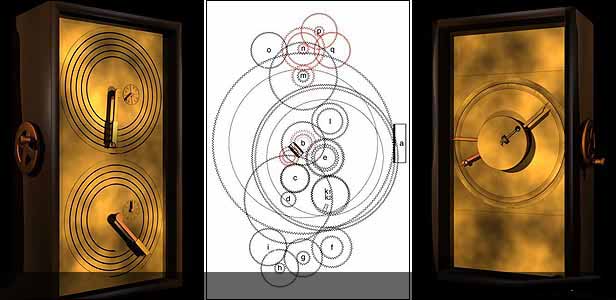
We find Hipparchus' mathematical signatures in the Antikythera Mechanism, an ancient astronomical computer of the 2nd century BC. The mechanism is based on a solar year, the Metonic Cycle, which is the period the Moon reappears in the same star in the sky with the same phase (full Moon appears at the same position in the sky approximately in 19 years), the Callipic cycle (which is four Metonic cycles and more accurate), the Saros cycle and the Exeligmos cycles (three Saros cycles for the accurate eclipse prediction).
The study of the Antikythera Mechanism proves that the ancients have been using very accurate calendars based on all the aspects of solar and lunar motion in the sky. In fact the Lunar Mechanism which is part of the Antikythera Mechanism depicts the motion of the Moon and its phase, for a given time, using a train of four gears with a pin and slot device which gives a variable lunar velocity that is very close to the second law of Kepler, i.e. it takes into account the fast motion of the Moon at perigee and slower motion at apogee. This discovery proves that Hipparchus mathematics were much more advanced than Ptolemy describes in his books, as it is evident that he developed a good approximation of Kepler's second law.
There has been speculation that the Mesoamerican Long Count calendar is somehow calibrated against the precession, but this view is not held by professional scholars of Mayan civilization.
A 12th century text by Bhaskara II says: "sampat revolves negatively 30000 times in a Kalpa of 4320 million years according to Suryasiddhanta, while Munjala and others say ayana moves forward 199669 in a Kalpa, and one should combine the two, before ascertaining declension, ascensional difference, etc." Lancelot Wilkinson translated the last of these three verses in a too concise manner to convey the full meaning, and skipped the portion combine the two which the modern Hindi commentary has brought to the fore. According to the Hindi commentary, the final value of period of precession should be obtained by combining +199669 revolutions of ayana with -30000 revolutions of sampaat to get +169669 per Kalpa, i.e. one revolution in 25461 years, which is near the modern value of 25771 years.
Moreover, Munjala's value gives a period of 21636 years for ayana's motion, which is the modern value of precession when anomalistic precession is also taken into account. The latter has a period of 136000 years now, but Bhaskar-II gives its value at 144000 years (30000 in a Kalpa), calling it sampan. Bhaskar-II did not give any name of the final term after combining the negative sampan with the positive ayana. But the value he gave indicates that by ayana he meant precession on account of the combined influence of orbital and anomalistic precessions, and by sampan he meant the anomalistic period, but defined it as equinox.
His language is a bit confused, which he clarified in his own Vasanabhashya commentary Siddhanta Shiromani]by saying that Suryasiddhanta was not available and he was writing on the basis of hearsay. Bhaskar-II did not give his own opinion, he merely cited Suryasiddhanta, Munjala and unnamed "others".
Yu Xi (4th century CE) was the first Chinese astronomer to mention precession. He estimated the rate of precession as 1° in 50 years.
In medieval Islamic astronomy, the Zij-i Ilkhani compiled at the Maragheh observatory set the precession of the equinoxes at 51 arc seconds per annum, which is very close to the modern value of 50.2 arc seconds.
In the Middle Ages, Islamic and Latin Christian astronomers treated "trepidation" as a motion of the fixed stars to be added to precession. This theory is commonly attributed to the Arab astronomer Thabit ibn Qurra, but the attribution has been contested in modern times. Nicolaus Copernicus published a different account of trepidation in De revolutionibus orbium coelestium (1543). This work makes the first definite reference to precession as the result of a motion of the Earth's axis. Copernicus characterized precession as the third motion of the earth.
Over a century later precession was explained in Isaac Newton's Philosophiae Naturalis Principia Mathematica (1687) to be a consequence of gravitation (Evans 1998, p. 246). However, Newton's original precession equations did not work and were revised considerably by Jean le Rond d'Alembert and subsequent scientists.
Mithraism was a mystery religion or school based on the worship of the god Mithras. Many underground temples were built in the Roman Empire from about the 1st century BC to the 5th century AD.
Understanding Mithraism has been made difficult by the near-total lack of written descriptions or scripture; the teachings must be reconstructed from iconography found in mithraea (a mithraeum was a cave or underground meeting place that often contained bas reliefs of Mithras, the zodiac and associated symbols). Until the 1970s most scholars followed Franz Cumont in identifying Mithras with the Persian god Mithra. Cumont's thesis was re-examined in 1971, and Mithras is now believed to be a syncretic deity only slightly influenced by Persian religion.
Mithraism is recognized as having pronounced astrological elements, but the details are debated. One scholar of Mithraism, David Ulansey, has interpreted Mithras (Mithras Sol Invictus - the unconquerable sun) as a second sun or star that is responsible for precession. He suggests the cult may have been inspired by Hipparchus' discovery of precession. Part of his analysis is based on the tauroctony, an image of Mithras sacrificing a bull, found in most of the temples. According to Ulansey, the tauroctony is a star chart.
Mithras is a second sun or hyper-cosmic sun and/or the constellation Perseus, and the bull is Taurus, a constellation of the zodiac. In an earlier astrological age, the vernal equinox had taken place when the Sun was in Taurus. The tauroctony, by this reasoning, commemorated Mithras-Perseus ending the "Age of Taurus" (about 2000 BC based on the Vernal Equinox Ð or about 11,500 BC based on the Autumnal Equinox).
The iconography also contains two torch bearing boys (Cautes and Cautopates) on each side of the zodiac. Ulansey, and Walter Cruttenden in his book Lost Star of Myth and Time, interpret these to mean ages of growth and decay, or enlightenment and darkness; primal elements of the cosmic progression. Thus Mithraism is thought to have something to do with the changing ages within the precession cycle or Great Year (Plato's term for one complete precession of the equinox).
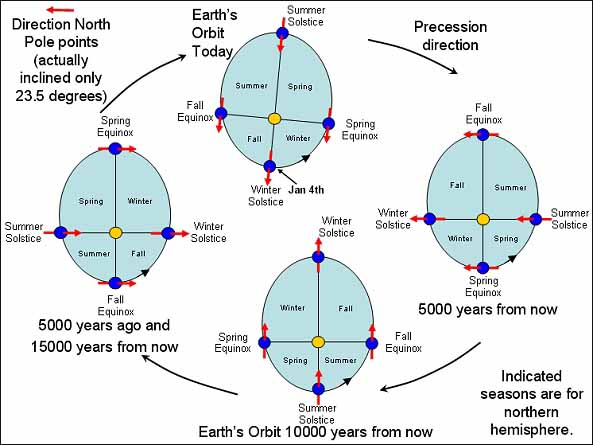
This figure illustrates the effects of axial precession on the seasons, relative to perihelion and aphelion. The precession of the equinoxes can cause periodic climate change (see Milankovitch cycles), because the hemisphere that experiences summer at perihelion and winter at aphelion (as the southern hemisphere does presently) is in principle prone to more severe seasons than the opposite hemisphere.
Hipparchus estimated Earth's precession around 130 BC, adding his own observations to those of Babylonian and Chaldean astronomers in the preceding centuries.
In particular they measured the distance of the stars like Spica to the Moon and Sun at the time of lunar eclipses, and because he could compute the distance of the Moon and Sun from the equinox at these moments, he noticed that Spica and other stars appeared to have moved over the centuries.
Precession causes the cycle of seasons (tropical year) to be about 20.4 minutes less than the period for the earth to return to the same position with respect to the stars as one year previously (sidereal year). This results in a slow change (one day per 71 calendar years) in the position of the sun with respect to the stars at an equinox. It is significant for calendars and their leap year rules. Read more ...
ASTROLOGY AND THE EARTH'S WOBBLE